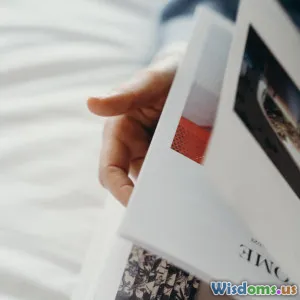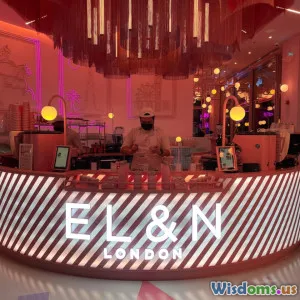
DataDriven Guide to Choosing Stock vs Original Imagery
8 min read Discover a data-driven framework for choosing stock versus original imagery in design projects, boosting creativity and ROI. (0 Reviews)
Data-Driven Guide to Choosing Stock vs Original Imagery
In an age overflowing with content, visuals play a critical role in capturing attention and shaping brand perception. Whether you’re a graphic designer, marketer, or business owner, you face a common dilemma: should you invest in custom original imagery or opt for readily available stock photos? The answer isn’t always intuitive, and a data-driven approach uncovers the true impact of this crucial choice.
This guide dives deep into the factors influencing this decision—cost, authenticity, agility, brand consistency, audience engagement, and more—backed by real-world data and examples.
Why Image Choice Matters More Than Ever
Research from the Nielsen Norman Group shows that our brains process images 60,000 times faster than text. In digital media, the first impression boils down to visuals. Adobe’s Content Profits Study found that posts with original photos score 35% higher engagement rates on social platforms compared to stock images. This underlines how the right imagery can be a strategic asset—not just decoration.
Yet, stock photography remains a backbone for many projects due to flexibility, affordability, and time efficiency. Balancing creativity and pragmatism requires an analytical mindset.
Section 1: The Anatomy of Stock Imagery
Accessibility and Cost Efficiency
Stock photo libraries like Shutterstock, Adobe Stock, and Getty Images offer millions of images. Subscription plans can cost as little as $29/month for access to thousands of images—often making them a tempting choice for startups and freelancers.
Example: A small startup with limited budget needed lifestyle photography for web banners post-launch. Stock images saved them $10,000+ compared to hiring a professional photographer.
Variety and Speed
Urgency often drives stock use. When turnaround times are tight, downloading stock assets instantly beats the days or weeks required for custom shoots.
Limitations Impacting Originality
However, common stock images bounce around the internet, diminishing brand uniqueness. HubSpot’s survey revealed nearly 54% of consumers find stock imagery less trustworthy or authentic. The overuse of generic visuals can unintentionally dilute brand personality.
Legal and Licensing Considerations
Although stock photos come with licenses, usage restrictions must be understood carefully. For example, many stock providers limit use in trademarked products or require additional purchases for extended rights.
Section 2: The Power of Original Imagery
Brand Authenticity and Differentiation
Original visuals offer the highest degree of brand authenticity. They reflect unique stories and values, which audiences connect with deeply.
Example: Airbnb makes use of original photography to showcase real homes and hosts, imparting trust and a sense of belonging—key differentiators in the hospitality sector.
Emotional Engagement and Customer Loyalty
A 2021 study by Sprout Social found that 70% of consumers felt more emotionally connected to brands using original user-generated visuals and photos, influencing higher repeat purchases.
Investment and Long-Term Value
The upfront cost of original imagery—typically ranging from $3,000 to $25,000 per project—translates into an asset that can be leveraged for years without fear of repeated exposure across competitors.
Challenges: Time, Budget, and Creative Direction
Original shoots demand planning, coordination, and resources—often unavailable to smaller teams. Creative disagreements or misaligned vision can also derail projects without clear direction.
Section 3: Using Data to Inform Your Image Strategy
Analyzing ROI Metrics
Tracking image-related KPIs like click-through rates (CTR), conversion, bounce rates, and social shares can quantitatively inform effectiveness.
Numerous case studies show original imagery improving campaign CTR by up to 28%.
Audience and Channel Considerations
- Social Media: Platforms such as Instagram and Pinterest reward authenticity. Original imagery often outperforms here.
- Corporate Websites: High stakes on credibility suggest original photos.
- Blogs and Informational Content: Stock images may suffice if they align well with content tone.
Hybrid Approach
Data supports combining the two: using stock for background, filler images and originals for hero shots and storytelling visuals optimizes cost and impact.
Example: HubSpot uses stock images for blog posts but original photos for case studies and the company About page.
Section 4: Practical Guidelines and Tools
Qualitative Decision Factors
Ask:
- Does this image reflect our brand’s voice?
- What is the context of use and audience expectation?
- How often will this image be reused?
Quantitative Decision Factors
Calculate:
- Budget allocation for imagery.
- Expected lifetime use and reach.
- Potential increase in engagement/conversion.
Tools to Support the Process
- Google Analytics and heatmaps: Measure webpage sections with different image types.
- A/B Testing Platforms: Compare performance of stock vs original across channels.
- Digital Asset Management (DAM): Organize and analyze imagery assets’ usage.
Conclusion: Making the Informed Choice
Choosing stock versus original imagery isn’t a binary decision but a strategic choice that depends on your goals, resources, and audience. While stock photos excel in immediacy, variety, and savings, original images deliver unmatched authenticity and engagement—often translating to long-term business value.
A data-driven strategy, blending qualitative brand insight with quantitative performance metrics, empowers you to select visuals that truly resonate.
As graphic designer and creative director Mike Kus says, “Originality builds trust. But knowing when to deploy it, backed by data, is what makes design work smart, not just pretty.”
By considering your project’s unique parameters and continuously measuring outcomes, you can perfect your visual storytelling and carve out an enduring competitive edge.
Ready to elevate your brand imagery? Start by auditing your current visuals against engagement data and set targeted experiments for stock versus original integration. Your best design decisions await in the numbers.
Rate the Post
User Reviews
Popular Posts





















